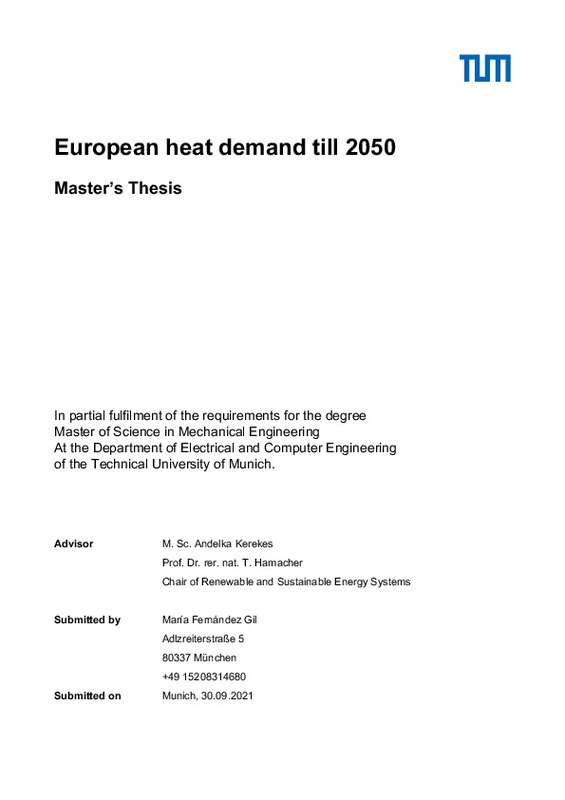JavaScript is disabled for your browser. Some features of this site may not work without it.
Buscar en RiuNet
Listar
Mi cuenta
Estadísticas
Ayuda RiuNet
Admin. UPV
Demanda europea de calor hasta 2050
Mostrar el registro sencillo del ítem
Ficheros en el ítem
| dc.contributor.advisor | Sanchis Sabater, Antonio
|
es_ES |
| dc.contributor.advisor | Kerekes, Andelka
|
es_ES |
| dc.contributor.author | Fernández Gil, María
|
es_ES |
| dc.date.accessioned | 2021-11-22T14:44:59Z | |
| dc.date.available | 2021-11-22T14:44:59Z | |
| dc.date.created | 2021-09-30 | |
| dc.date.issued | 2021-11-22 | es_ES |
| dc.identifier.uri | http://hdl.handle.net/10251/177367 | |
| dc.description.abstract | [ES] En el futuro será necesario cambiar la estructura de los vectores energéticos en el sector del calor, que hoy en día se cubren mayoritariamente con combustibles fósiles. Conociendo la demanda de calor es posible optimizar su producción, teniendo en cuenta la optimización del coste del sistema energético y limitando al mismo tiempo las emisiones de CO2. Por esta razón, es crucial prever la demanda de calor en Europa por país y región NUTS2, con el objetivo de hacer un análisis sólido de las posibles tecnologías futuras que se adapten al perfil de la demanda de calor en Europa 2050. Para ello se utilizará un modelo de demanda energética centrado en todo el sector industrial, obteniendo datos de cada subsector industrial por resolución NUTS2. Para asegurar la consistencia de los datos, se realizará también una validación de los mismos con otros estudios nacionales y europeos. El modelo utilizado para la previsión de los datos se llama endemo (modelización de la demanda energética), que calcula no sólo la demanda de calor en Europa 2050 por NUTS2, sino también la demanda de electricidad e hidrógeno. Una vez obtenidas estas demandas de energía útil, es posible hacer el acoplamiento de estos sistemas en Europa. Esto se hará en la herramienta de optimización urbs, generando un escenario futuro realista que nos ayudará a alcanzar los altos objetivos de reducción de emisiones de gases de efecto invernadero y a mantener los costes de nuestro sistema energético de forma realista. El objetivo final de mi proyecto será seleccionar las tecnologías más adecuadas y sostenibles para el futuro, así como determinar las demandas energéticas finales, en función del análisis realizado en urbs y mis datos pronosticados de endemo. | es_ES |
| dc.description.abstract | [EN] Changes on the structure of the energy carriers on the heat sector, which are nowadays mostly covered by fossil fuels, will be needed in the future. Knowing the heat demand it is possible to optimize how it will be produced, considering the optimization of the cost of the energy system and at the same time limiting the CO2 emissions. For this reason, it is crucial to forecast the heat demand in Europe by country and NUTS2 region, with the aim of doing a robust analysis of the future possible technologies that will suit the heat demand profile in Europe 2050. This will be done by means of an energy demand model focused on the whole industry sector, obtaining data of each industry sub-sector by NUTS2 resolution. To assure the consistency of the data, a validation of the data with other national and European studies will be also done. The model used to forecast the data is called endemo (energy demand modeling), which calculates not only the heat demand in Europe 2050 by NUTS2 but also the electricity and hydrogen demand. Once these useful energy demands are obtained, it is possible to do the coupling of these systems in Europe. This will be done in the optimization tool urbs, generating a realistic future scenario that will help us to achieve the high goals of green gas emission reduction and keep the costs of our energy system realistic. The last aim of my project will be to select the most suitable and sustainable technologies for the future as well as to determine the end energy demands, depending on the analysis done in urbs and my forecasted data from endemo. | es_ES |
| dc.format.extent | 118 | es_ES |
| dc.language | Inglés | es_ES |
| dc.publisher | Universitat Politècnica de València | es_ES |
| dc.rights | Reserva de todos los derechos | es_ES |
| dc.subject | Previsión | es_ES |
| dc.subject | Demanda de calor | es_ES |
| dc.subject | Demanda energética | es_ES |
| dc.subject | Hidrógeno | es_ES |
| dc.subject | Electricidad | es_ES |
| dc.subject | Sostenible | es_ES |
| dc.subject | Modelización | es_ES |
| dc.subject | Endemo | es_ES |
| dc.subject | Urbs | es_ES |
| dc.subject | Forecast | es_ES |
| dc.subject | Heat demand | es_ES |
| dc.subject | Energy demand | es_ES |
| dc.subject | Hydrogen | es_ES |
| dc.subject | Electricity | es_ES |
| dc.subject | Sustainable | es_ES |
| dc.subject | Modeling | es_ES |
| dc.subject.classification | FISICA APLICADA | es_ES |
| dc.subject.other | Máster Universitario en Ingeniería Industrial-Màster Universitari en Enginyeria Industrial | es_ES |
| dc.title | Demanda europea de calor hasta 2050 | es_ES |
| dc.type | Tesis de máster | es_ES |
| dc.rights.accessRights | Abierto | es_ES |
| dc.contributor.affiliation | Universitat Politècnica de València. Departamento de Física Aplicada - Departament de Física Aplicada | es_ES |
| dc.contributor.affiliation | Universitat Politècnica de València. Escuela Técnica Superior de Ingenieros Industriales - Escola Tècnica Superior d'Enginyers Industrials | es_ES |
| dc.description.bibliographicCitation | Fernández Gil, M. (2021). Demanda europea de calor hasta 2050. Universitat Politècnica de València. http://hdl.handle.net/10251/177367 | es_ES |
| dc.description.accrualMethod | TFGM | es_ES |
| dc.relation.pasarela | TFGM\146397 | es_ES |
Este ítem aparece en la(s) siguiente(s) colección(ones)
-
ETSII - Trabajos académicos [10404]
Escuela Técnica Superior de Ingenieros Industriales






